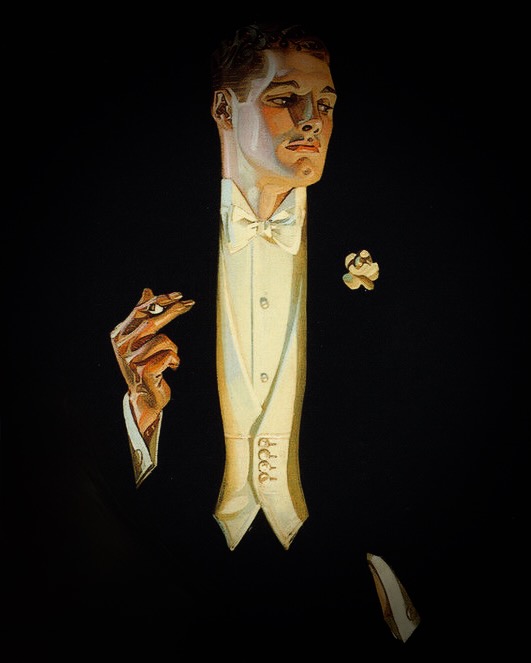
“Reginald slid a carnation of the newest shade into the buttonhole of his latest lounge coat and surveyed the results with approval. ‘I am just in the mood,’ he observed, ‘to have my portrait painted by someone with an unmistakable future. So comforting to go down to posterity as ‘Youth with a Pink Carnation’ in catalogue-company with ‘Child with a Bunch of Primroses’ and all that crowd.” — Saki, The Innocence of Reginald
Some years ago I attended a cocktail party at Saks 5th Avenue to open “Dressing the Part,” NYU’s Eighth Fashion Conference. As I was to deliver a lecture at the conference on “Dandyism Then and Now,” as well as uphold the honor of Dandyism.net, I felt an obligation to look my dandy best. I exfoliated. I had a facial, a haircut and a manicure. A manicure always raises for me the perplexing question of whether I should have my nails polished. In northern New Jersey, where I reside, there is a long and rich tradition of gentlemen having their nails polished. This tradition is so strong that most continue to do so even after they have entered the Federal Witness Protection Program. Nevertheless, I passed. I had my teeth bleached. I went to my tanning salon. I followed Dr. Perricone’s prescription for a glowing complexion and ate wild salmon two meals a day for three days.
The day of the event I carefully picked out my wardrobe. I wore a cashmere-and-wool navy blue suit with double shadow chalk-stripes; a blue-yellow-white striped shirt with spread collar and French cuffs; a woven tie of yellow ground and a shadow diagonal strip with tiny alternating red and white diamonds; and a red silk pocket square – the proverbial quadruple lutz. I “bottomed it off” with red socks, to match the handkerchief and the diamonds in the tie, and a pair of dark brown reverse calf cap-toes.
With Reginald in mind, I stopped by a florist near Saks for a boutonniere. I asked for a white flower, to bring out, I said, the shadow chalk-stripe of the suit. The florist spun around into the bin, cut a flower from its stem and pinned it to my lapel. “No charge,” he said, in obvious deference to the eternal image of the dandy.
Outside the shop, I stopped to admire my reflection in a store window. Sacré bleu! He had pinned the flower to my lapel somewhere just north of my navel. Worse, though, what was the flower? There were two fine tiny white blooms, but dangling above them were two green-hued buds, looking like nothing so much as the wizened gonads of an ancient dwarf. This would never do. Quickly I removed the offending boutonniere. Then I hied myself to the unisex restroom in the Elizabeth Arden Salon in the concourse level of Saks. With my ever-present Swiss Army knife I pruned the offending buds and re-positioned the surviving two blooms in my lapel buttonhole.
Thus resplendent, I repaired to the cocktail party. The first person I met was “manton” from StyleForum. Did he notice my suit? Did he notice my masterly combination of color, design, and texture? No, he noticed my boutonniere. “Nice touch,” he said, or words to that effect. “I should wear one to the conference myself.” We kibitzed for an hour, introduced ourselves to the conference organizer, and helped ourselves to several flutes of kir and champagne, as well as to the tiniest of hors d’oeuvres. Then manton took his leave.
It was time for me to sparkle. I went over to the other, less crowded side of the room. With the languid yet regal pose of a lion of the Second Empire, I draped myself over a chair, thus artfully exposing a glimpse of my red socks. Soon, women started sashaying over (all right, a goodly number rolled over in their wheelchairs, that’s the demographic to which my appeal is skewered). “I love your boutonniere.” “Your red socks look fabulous.” “You certainly look like an expert on dandyism.”
So I say to you aspiring dandies: Put aside your quest to achieve the ideal of a transcendent dandy who unites internal beauty, spiritual enlightenment, and visible elegance. Instead, put on a pair of red socks and stuff a damn petunia in your lapel. But before you do, read this book. More accurately, study the photographs. The book contains a manual of 23 high-quality, half-page, full-color photographic studies of the boutonniere. Ten photos involve mufti; thirteen are formal outfits. These studies show how, contrary to the advice of some, one can wear a boutonniere and a pocket square together. Just be sure that the flower itself is small. Because of the contrast with the natural curves of the flower, the angular look of the oft-maligned “TV” fold (the handkerchief folded with a straight horizontal edge showing) is especially effective. A slight puff (which is what I wore) is also a good match.
The book’s photographs suggest other ways to add flair with a boutonniere. Put one in the lapel of your overcoat: It brightens and breaks up what can be the monolithic expanse of the coat. Or place your boutonniere in a sterling silver holder. It may look fussy on Hercule Poirot, but he is a fussy little dandy. It looks ever so elegant on Rupert Everett in “An Ideal Husband,” as his attire is more trim and spare.
The book also has entertaining photographs of various dandy icons sporting a boutonniere: Grant, Astaire, Niven, James Bond (in three incarnations: Connery, Moore and Dalton), Oscar Wilde, the Duke of Windsor, Gabriele D’Annunzio and Proust, among others. Sadly, the book’s text, a pastiche by different authors, is uneven. A history of the boutonniere by the great contemporary dandy Nick Foulkes is educational. The meditation by Umberto Angeloni, the head of Brioni, on the decline of the boutonniere and a call for its resurgence, is stimulating. On the other hand, the history of floral design in menswear is tangential at best, and a personal reminiscence of a failed childhood attempt at “boutonniering” irrelevant. The various lists of flowers are mere filler. Strewn throughout the book are devotees’ personal testaments of the rewards and pleasures of the boutonniere. These are engaging.
Yet perhaps the best testament to the boutonniere appears not in this book, but comes from someone on this very website: “When I used to dress in boulevardier style for the office, I often wore a boutonniere, and the sight of a flower on a man charmed the pants off a few young ladies.” Especially, I should add, if paired with red socks. — NICK WILLARD

Do you know where I might find a silver boutonniere holder/pin that David Suchet made famous?